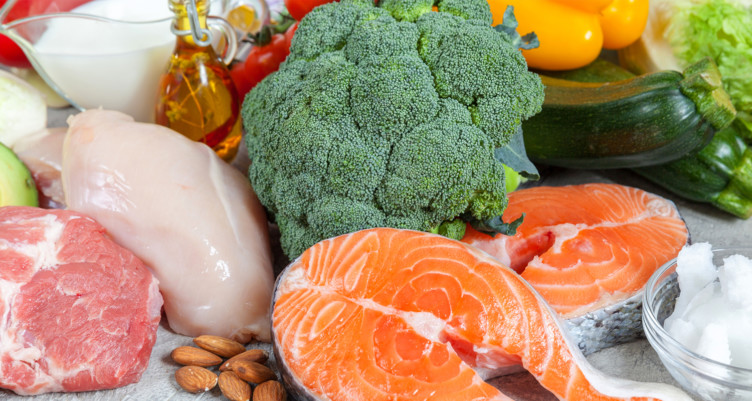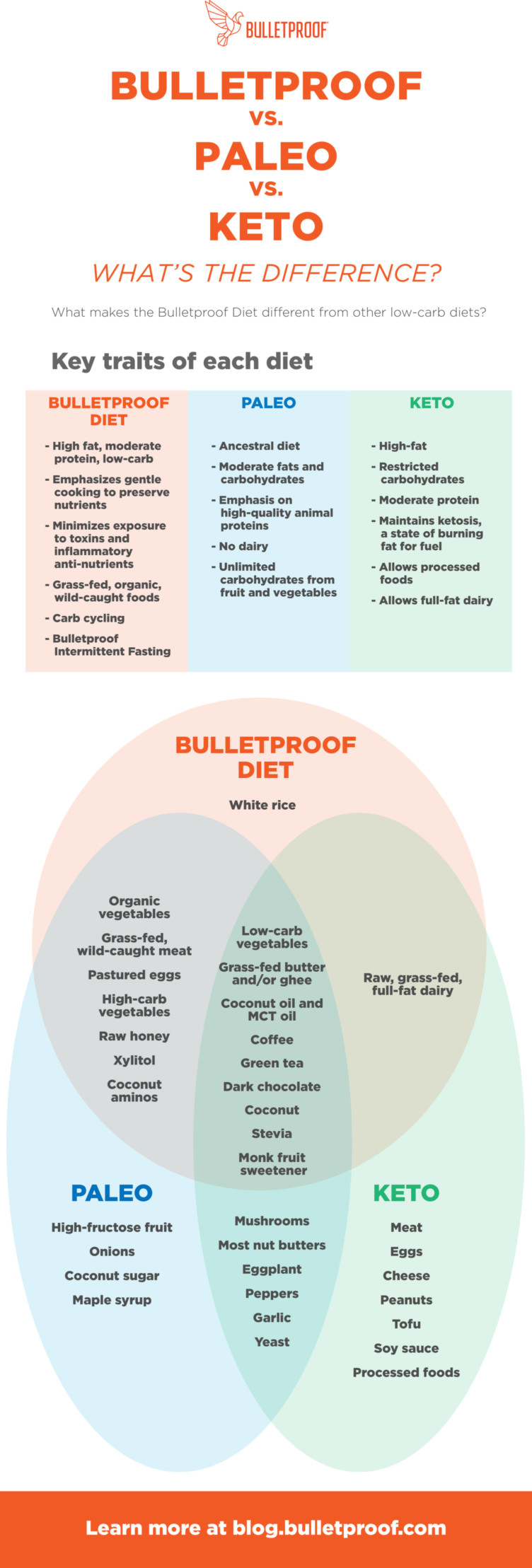Bulletproof vs. Paleo vs. Low-Carb and Ketogenic Diets: What’s The Difference?

- On the Bulletproof Diet, you eat lots of quality fat, high-quality protein, and minimal carbohydrates.
- It’s designed to melt body fat, improve focus, and boost your overall performance by limiting your exposure to anti-nutrients, toxins, hormones, and other junk that makes you weak.
- The Paleo diet is a primal or ancestral diet based on the types of foods presumed to have been eaten by early humans — meat, fish, vegetables, and fruit.
- The ketogenic diet places you in a fat-burning state called ketosis. To get there, you eat lots of fat, moderate protein, and very few carbs.
- There is quite a bit of overlap in what foods you eat on Paleo vs. keto vs. Bulletproof. Read on to understand the key differences, and what makes Bulletproof stand out.
Choosing the right diet makes all the difference in how you feel every day. I was in my 20s when I started suffering from severe fatigue and cognitive dysfunction. I was 300 pounds, sick constantly, and almost had to drop out of grad school because I couldn’t concentrate.
Back then, I thought my inability to think clearly and perform at high levels was some sort of moral failing. I would beat myself up. I would work harder and stay up later, trying to catch up with my peers.
I tried every diet imaginable, including raw vegan, keto, and Paleo, and spent years falling off the low-fat bandwagon. I hit the treadmill for hours every day. Nothing worked. So I took matters into my own hands.
“The Bulletproof Diet” was born after a decade of working with some of the world’s top health and nutrition researchers. Over a span of about 15 years, I devoured thousands of research papers and books on human nutrition. I used my body as a testing ground to determine what worked best for my biology.
The result is a diet that has helped thousands of people lose fat and gain the energy and clarity they thought they’d lost forever. So, what differentiates the Bulletproof Diet from other low-carb diets? Read on to find out.
Related: Take the guesswork out of keto with this 7-Day Cyclical Keto Meal Plan, plus Keto Recipes Cookbook
Bulletproof vs. keto vs. Paleo: The big picture

If you were to map out the most popular diets, you’d see a vast spectrum of practices and plans ranging from low-fat vegan to high-fat, low-carb (HFLC). This deliciously fatty end of the spectrum is where the Bulletproof Diet and the keto, Paleo, and Atkins diets would lie.
Keto

The ketogenic diet is a style of eating that places you in ketosis — a state in which your body burns fat for fuel, instead of carbs. To achieve this state, you eat lots of high-quality fat, moderate protein, and very few carbs. This diet doesn’t specify how you hit your macros, and it doesn’t restrict full-fat dairy. Learn more about keto with this detailed beginner’s guide.
Paleo

The Paleo diet eliminates processed foods and focuses on what our Paleolithic ancestors ate — mostly meat, plants, nuts, and seeds. It excludes dairy, grain products, and sugary processed foods. The Paleo diet uses proteins and quality fats to support strong muscles, healthy bones, and optimal immune function.
The Bulletproof Diet

The Bulletproof Diet is similar to these diets, but it upgrades your life by taking your food a step further. The Bulletproof Diet is designed to maximize your willpower by reducing cravings and minimize aging by focusing on how food works in your body on a biochemical level. Cavemen didn’t have mass spectrometers and microscopes and modern science. They weren’t biohackers and lacked the control of their environment that we take for granted today.
New to the Bulletproof Diet? Here’s the overview:
- The Bulletproof Diet tells you what type of food to eat, when to eat it, and how to cook it.
- It features high amounts of quality fats, moderate amounts of high-quality protein, and tons of organic vegetables. You eat within certain timeframes in order to create unbelievable levels of energy and mental clarity throughout the day.
- It identifies the exact foods that provide the most energy and contain the least performance-robbing, inflammation-causing anti-nutrients and toxins.
- It hacks the root of food cravings, allowing you to lose weight with zero hunger or a battle of willpower.
While the Paleo and Bulletproof diets agree that sugar and grains aren’t really food, Bulletproof came about through anti-aging, cognitive performance, and fertility research, not by focusing on ancestral health. The Bulletproof Diet is different than Paleo and similar diets because it takes into account the factors outlined below.
The Bulletproof approach to fats, meat, and carbs

The Bulletproof Diet focuses on both quality and quantity: the quality of your food is super important, but you should also play around with the ratios of fat, protein, and carbs you consume. We encourage a bit more fat than most Paleo authors (50-70% or more), including butter (a food that’s been debated in the Paleo community for a while), and moderate protein consumption.
This is opposed to most Paleo meal plans, which offer a bit more protein, and moderate fat and carb consumption.
One of Bulletproof’s most distinguishing, most effective features in making you feel your best is that it encourages you to eat more fat than most low-carb diet plans and includes one day per week of protein fasting. Pretty unheard of in the Paleo scene.
And of course, there’s Bulletproof Coffee, which isn’t technically Paleo, because cavemen didn’t have butter, lab-tested mold- and toxin-free coffee, or the ability to concentrate the most useful 6% of coconut oil in a non-oxygen atmosphere (i.e. Brain Octane Oil). Or blenders. Cavemen didn’t have those either. But Bulletproof Coffee totally rocks when you add it to the Paleo template!
A focus on food quality

Think about how vegans, particularly raw vegans, pay attention to food quality. They’re obsessive for a reason — because it matters! On the Bulletproof Diet, you eat grass-fed, wild-caught, and organic foods because they have more nutritional value and fewer hormones, pesticides, and other toxins that can mess with your mojo. Check out my two-part series on why grass-fed beef is healthier than grain-fed.
Bulletproof food quality principles agree with veganism on food quality more so than, say, Atkins diet followers. Many people who follow an Atkins or general low-carb diet will eat non-organic produce and grain-fed meat out of a sense of convenience — or maybe they just don’t know any better. But these foods contain hormones, pesticides, and other toxins that can harm your performance and make you slow, tired, and unfocused. A Bulletproof Diet includes nutrient-dense, high-quality foods that feed your body at a cellular level and minimize your body’s exposure to harmful chemicals and mold. Learn more about how mold affects your performance.
A focus on food processing

You likely know that processing your food is bad. But cooking food is processing food, even if you do it yourself. The Bulletproof approach to nutrition focuses on how your food is prepared or cooked. That means cooking your food gently and avoiding overcooking or charring your meat.
Cavemen stuck their meat on a stick over a fire and they created heterocyclic amines and polycyclic aromatic hydrocarbons (a.k.a. HCAs and PAFs, capable of damaging DNA after they are metabolized), a topic ”The Bulletproof Diet” specifically addresses and teaches you how to avoid. The bottom line is that better prep = better food.
Some Paleo authors might recommend crispy bacon or charred, heavily cooked meats — Bulletproof does not. Gently cook your foods, or they will lose some of their most important nutrients.
Pitfalls of Paleo and keto: Why you should customize your diet

If you strictly follow the Paleo diet, you don’t eat any dairy at all — but then you’d miss out on all the benefits of grass-fed butter or raw dairy, if you tolerate it. On the ketogenic diet, severely restricting carbs for extended periods of time can lead to impaired sleep quality and thyroid problems. That’s why the Bulletproof Diet advocates carb cycling, also known as keto cycling.
Meanwhile, no two Bulletproof Diet followers eat the exact same way or take the exact same supplements.
We like to think of it as “this is more Bulletproof or less Bulletproof.” Everybody is different, but the Bulletproof Diet Roadmap makes it easy to identify potentially performance-robbing, brain-fog inducing Kryptonite foods that make it hard to reach your peak mental and physical performance.
Maybe you should eat nightshades, maybe you shouldn’t. The best way to find out is to try both for yourself and see what kind of difference you feel. But if you don’t have a spectrum to tell you that these are suspect, then you have no way of telling how the foods you put in your body are affecting your everyday performance.
The only way to really figure out which foods may be giving you problems is to use your body as a testing ground. This means eliminating suspect foods, then methodically adding them back in. There are some guidelines on how to do this in “The Bulletproof Diet.”
Food, technology, and timing

It’s OK to improve food through the use of technology. The Bulletproof Diet doesn’t reject improvement of food using technology, like xylitol. Birch sugar is totally acceptable on this diet, even if it is made in a lab, because the biochemistry works. It’s also OK to use supplements to help you digest your food or promote better energy or sleep.
The Bulletproof Diet also incorporates some meal timing elements that various versions of Paleo have yet to adopt. For example, Bulletproof Intermittent Fasting is not the Paleo-approved plain intermittent fasting because you’re drinking Bulletproof Coffee, but it works very well, giving you energy and clarity throughout your day. Bulletproof also encourages you to time your carb consumption to improve sleep quality.
Is Bulletproof a ketogenic diet?

Yes … and no. It does emphasize a diet high in high-quality fats, and it utilizes intermittent, cyclical ketosis to melt fat and promote high energy. However, the Bulletproof Diet discourages long-term ketosis for everyone. Some people struggle with thyroid or hormone problems, adrenal fatigue, poor sleep quality, and extremely dry eyes when they severely limit their carb intake. On the Bulletproof Diet, you moderately increase your carbs (and go out of keto) once per week to support your body’s systems.
The Bulletproof Diet also places more importance on food quality. On the ketogenic diet, it’s possible to achieve ketosis by eating a high-fat diet filled with grain-fed meat, but you won’t feel your best. When you eat grass-fed meat, wild-caught seafood, and organic vegetables, you limit your exposure to anti-nutrients, toxins, antibiotics, and hormones that make you feel sluggish and weak.
The bottom line

Paleo is committed to the ancestral modality, and I’m a fan of it. Meanwhile, the Bulletproof Diet focuses on the research behind ways to improve performance and mental clarity by providing ample amounts of resources for your body’s building blocks.
But we’re all friends. We’re all working toward higher food quality, more grass-fed meat from healthy animals, better vegetables, and higher-performance humans.

Sign up for early access to sales, product launches, the latest Bulletproof news and more!



